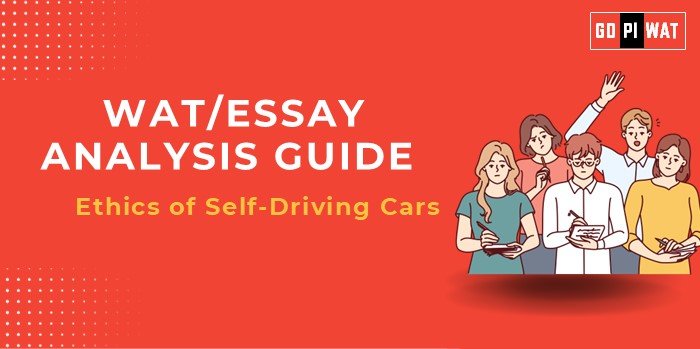📋 Written Ability Test (WAT)/Essay Analysis Guide: Ethics of Self-Driving Cars
🌟 Understanding the Topic’s Importance
Autonomous vehicles represent a transformative technology intersecting AI, ethics, and public safety. Essays on this topic reveal your ability to analyze moral dilemmas, apply critical reasoning, and propose actionable solutions.
⏳ Effective Planning and Writing
- 📝 Time Allocation:
- Planning: 5 minutes.
- Writing: 20 minutes.
- Review: 5 minutes.
📖 Introduction Techniques for Essays
- ⚖️ Contrast Approach: “While self-driving cars promise a 94% reduction in accidents, ethical dilemmas like passenger vs. pedestrian safety threaten public trust in their deployment.”
- 💡 Solution-Based Approach: “Can self-driving cars ethically prioritize lives? Addressing this question is essential for ensuring their success in society.”
📚 Structuring the Essay Body
1. Achievements:
- 🚦 Reduced accidents.
- 🏙️ Efficiency in urban transport.
- 🌐 Development of global ethical guidelines.
2. Challenges:
- ⚖️ Algorithmic bias.
- ❓ Ethical conflicts, such as passenger vs. pedestrian prioritization.
- 📜 Legal ambiguities and liability issues.
- 🤔 Public acceptance and trust challenges.
3. Future Outlook:
- 🤝 Collaborative frameworks between nations and stakeholders.
- 🤖 Smarter AI with context-specific decision-making.
- ⚖️ Equitable programming reflecting diverse societal values.
🔚 Concluding Effectively
- 🌀 Balanced Conclusion: “The success of self-driving cars hinges on ethical programming that balances safety, equity, and public trust.”
- 🌍 Global Perspective Conclusion: “Ethical dilemmas in AI programming will define the future of autonomous vehicles, shaping global transport norms.”
📊 Analyzing Successes and Shortcomings
- ✔️ Achievements: Safer roads, economic growth, global policy discussions.
- ❌ Challenges: Data misuse, regional disparities in safety guidelines.
💡 Recommendations for Sustainable Progress
- ✅ Develop global ethical AI frameworks.
- 👥 Conduct community-level consultations for algorithm programming.
- 📜 Establish clear liability policies for accidents.
✍️ Sample Short Essays
1. Balanced Perspective (100 words):
“Self-driving cars promise safer roads but pose ethical dilemmas, like prioritizing passengers or pedestrians. Resolving this requires a harm-minimization approach guided by global ethical frameworks. Germany’s guidelines offer a starting point, prioritizing life over property while advocating context-specific programming. Policymakers must balance innovation with public trust to enable sustainable deployment.”
2. Solution-Oriented (100 words):
“Can technology decide who lives and dies? For self-driving cars, the answer lies in transparent ethical programming. By integrating harm-reduction algorithms and prioritizing societal good, developers can navigate dilemmas like passenger vs. pedestrian safety. Collaborative efforts, such as Germany’s legal frameworks and global AI principles, can ensure ethical and equitable solutions.”
3. Global Comparison (100 words):
“Autonomous vehicle ethics vary globally, with Germany emphasizing life-first principles and the US prioritizing rapid deployment. These approaches reflect broader societal values, underscoring the need for universal AI guidelines. By learning from these examples, self-driving cars can address dilemmas, like passenger versus pedestrian safety, ensuring public trust and global scalability.”


